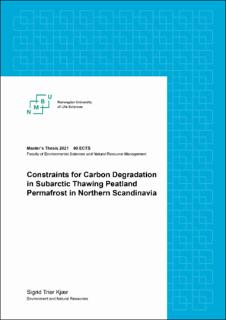| dc.contributor.advisor | Dörsch, Peter | |
| dc.contributor.advisor | Westermann, Sebastian | |
| dc.contributor.advisor | Althuitzen, Inge | |
| dc.contributor.author | Kjær, Sigrid Trier | |
| dc.date.accessioned | 2021-10-08T11:56:07Z | |
| dc.date.available | 2021-10-08T11:56:07Z | |
| dc.date.issued | 2021 | |
| dc.identifier.uri | https://hdl.handle.net/11250/2788732 | |
| dc.description.abstract | Permafrost soils are globally under pressure and subject to climate change induced permafrost thawing. Peat plateaus are found in peatlands with discontinuous permafrost and store large quantities of carbon (C). They are particularly vulnerable to climate change which leads to thawing of permafrost, collapse of peat plateaus and thermokarst formation. The aim of this thesis was to investigate potential rates and controlling factors for C degradation in peat plateaus in Northern Norway. Ongoing thawing of peat plateaus is known to mobilise C, but the understanding of what controls the biogeochemical turnover of C in these subarctic environments is still limited. This study compared three peat plateaus (Iškoras, Áidejávri and Lakselv) in Finnmark, Norway which represent a well-documented chronosequence of permafrost formation.
Peat cores from each site were incubated either oxically or anoxically at 10°C after controlled thawing. The cores were divided in seven layers representing both active layer, transition zone and permafrost peat. Chemical properties of each layer were determined, including pH, water-extractable dissolved organic carbon (DOC), element composition and stable isotope ratios of C and nitrogen (N). Kinetics of oxygen (O2) uptake as well as carbon dioxide (CO2) and methane (CH4) release were recorded at high temporal resolution during the first 19 days after thawing using an automated, temperature-controlled incubator coupled to a gas chromatograph. After 19 days, incubation was continued off-line with weekly or biweekly gas measurements until a total incubation time of 96 days. Release of DOC was measured in the slurry treatments after 0, 17 and 96 days. Two additional experiments were performed with permafrost peat from Iškoras, testing the effect of native DOC and nutrient addition (glucose, phosphate, ammonium, and sulphate) on organic matter (OM) decomposition.
Carbon degradation varied among the three peat plateaus, but all showed a similar trend over depth with highest CO2 production in the top of the active layer and a second maximum in the permafrost layer. CO2 production of thawed permafrost peat under oxic conditions was 42 - 104% of that of the active layer, demonstrating a substantial CO2 production potential of thawed permafrost peat. Highest decomposition rates were obtained under oxic conditions, but the DOC release was larger under anoxic conditions and in general much larger than CO2-C release. Leached DOC may lead to GHG emissions downstream of peat plateaus. CO2 accumulation showed a positive relationship with the initial concentration of native DOC which was most pronounced when O2 was present, indicating that some fraction of the DOC released from permafrost was instantly available for microbial decomposition. Experiments with nutrient additions showed that C decomposition only increased if nutrients were added in combination with glucose, which exemplifies the pivotal role of C quality for microbial decomposition activity. Anoxic CH4 formation and release were several orders of magnitude smaller than anoxic CO2 production, making it unlikely that CH4 formation is a significant pathway of C degradation upon permafrost thaw. Nitrous oxide (N2O) production was small and only seen in few active layer samples incubated anoxically. Overall, peat quality seemed to be a strong controller of decomposition activity with C content, peat C/N ratio, pH and iron content being the most important predictors. The distribution of δ13C and δ15N along the peat profile proved to be a useful indicator for site-specific peat formation and perturbation history and hence peat quality. | en_US |
| dc.description.abstract | Permafrostjorde er globalt set under stort pres. Klimaforandringer og stigning i globale temperaturer forårsager optøning af permafrosten. Palsaer er tørvejord opløftet af permafrost, og de fungerer som lagre for store mængder karbon (C). De er særligt sårbare over for klimaforandringer, idet disse fører til optøning og kollaps af palsaerne og videre til dannelse af termokarstsøer. Det er velkendt, at den igangværende optøning af palsaer mobiliserer C, men forståelsen af, hvilke faktorer der begrænser nedbrydningen af C i disse subarktiske områder, er forsat begrænset. Dette speciale undersøgte tre palsaer (Iškoras, Áidejávri and Lakselv) i Finnmark i Norge, for at sammenligne potentielle nedbrydningsrater og kontrollerende faktorer. Tilsammen udgør de tre palsaer en veldokumenteret kronosekvens af permafrost.
Tørvekerner fra hver af de tre palsaer blev inkuberet enten aerobt eller anaerobt ved 10°C efter kontrolleret optøning. Kernerne blev opdelt i syv lag, hvoraf tre lag repræsenterede aktivlaget, et lag overgangszonen og tre lag permafrostlaget. For hvert lag blev de kemiske egenskaber bestemt, herunder pH, opløst organisk karbon (DOC), grundstofsammensætning og forhold mellem naturlig forekommende stabile isotoper af henholdsvis C og nitrogen (N). Gaskinetik for optag af oxygen (O2) samt udslip af kuldioxid (CO2) og metan (CH4) blev målt med høj tidslig opløsning i de første 19 dage med en automatisk, temperaturkontrolleret inkubator koblet til en gaskromatograf. Inkubationen blev efter 19 dage fortsat med manuelle gasmålinger hver eller hver anden uge indtil 96 dage efter start af inkubationen. Frigørelse af DOC blev målt efter dag 0, 17 og 96. To tillægsforsøg blev udført med permafrosttørv fra Iškoras for at teste effekten af allerede tilstedeværende DOC og effekten af tilsætning af en række næringsstoffer (glukose, fosfat, ammonium og sulfat) på nedbrydning af tørv. | en_US |
| dc.language.iso | eng | en_US |
| dc.publisher | Norwegian University of Life Sciences, Ås | en_US |
| dc.rights | Attribution-NonCommercial-NoDerivatives 4.0 Internasjonal | * |
| dc.rights.uri | http://creativecommons.org/licenses/by-nc-nd/4.0/deed.no | * |
| dc.title | Constraints for carbon degradation in subarctic thawing peatland permafrost in Northern Scandinavia | en_US |
| dc.type | Master thesis | en_US |
| dc.description.localcode | M-MINA | en_US |

